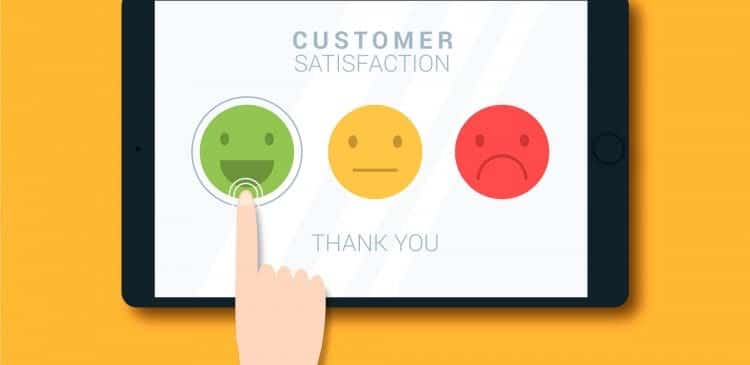As a business owner, it can be overwhelming to stay on top of all the customer feedback you receive each day- from emails, surveys, social media mentions, and more.
But keeping on top of this crucial information is critical for ensuring customer loyalty and creating a positive rapport with your customers.
That’s why we have created the ultimate guide to understanding and processing customer feedback so you can use it effectively to make improvements in your business! In this blog post, we’ll cover finetuning how you solicit feedback, deciphering response data like no code Sherlock Holmes and more – so let’s dive right in!
What is Customer Feedback?
Customer feedback is the information and opinions customers give about their experiences with a business, product, or service.
This can come from various sources such as online reviews, surveys, and social media comments. Feedback provides valuable insights into customer satisfaction levels, which can be used to drive positive changes in your business operations.
Advantages of Customer Feedback

There are numerous ways in which customer feedback proves to be advantageous for the business.
Building Trust and Loyalty
By responding to customer feedback, businesses can build trust and loyalty among their customers and create personal relationships. This will show your customers that you care about their experience with your business and respect their opinions.
Gain Customer Insights
Customer feedback provides valuable insights into customer satisfaction levels, which can be used to drive positive changes in your business operations. This allows you to identify areas of improvement, understand customer preferences and needs, and improve customer service.
Improving Your Products
By understanding customer feedback, you can gain valuable insights into how your products are performing and what customers think about them. You can use this information to make necessary changes or improvements to your products, allowing you to stay ahead of the competition.
Better Customer Experience
By responding to customer feedback, you can ensure that your customers are happy and satisfied with their experiences. This helps you create a better overall customer experience, leading to higher levels of customer satisfaction and loyalty.
Make Informed Business Decisions
By analyzing customer feedback data, you can make informed business decisions and create strategies that will ensure your customers’ needs are being met. This allows you to increase customer satisfaction and drive more revenue for your business.
Disadvantages of Customer Feedback

Although there are many uses for customer feedback, in some cases, it might be useless for a business.
Time-Consuming
Gathering customer feedback can be a time-consuming process. You need to make sure that your surveys or questionnaires are properly designed, and you also have to analyze the data in order to draw meaningful conclusions.
Hard to Get Genuine Feedback
Getting genuine feedback from customers can be difficult as some customers may not be willing to honestly share their opinions. Additionally, there is always the risk of biased responses or fake reviews, which may lead to wrong conclusions.
Shines a Spotlight on Customer Dissatisfaction
Customer feedback can also be used to highlight customer dissatisfaction, which may lead to negative publicity for the business. This could potentially damage your reputation and lead to a decline in sales.
If there is a flaw in the product, the customer mentions it in hope that next time it will be mended. But it is not always possible for a business to cater to such a huge number of demands from so many users. So, the business fails to act upon those mistakes.
Biased Opinions
Customers can be biased about a lot of things. It might be the case that a customer is not providing honest feedback but is instead, giving a feedback that suits his/her needs. This type of feedback is not at all helpful for businesses as it would result in them making changes that are not actually required.
Best Customer Feedback Quesitons
When gathering customer feedback, it is important to make sure that the questions are well-crafted and relevant. Here are some of the best customer feedback questions:
• What do you like most about our product/service?
• How satisfied are you with our customer service?
• What can we do to improve your experience with our product/service?
• Is there anything we can do to make our product/service better?
• What could we be doing differently to provide a better experience for you?
• What do you think of our website/app usability?
• How likely are you to recommend us to your friends or family?
• What other features would you like to see in our product/service?
How to Ask for Customer Feedback
When seeking customer feedback, it’s important to be clear about what you’re asking and why. You should also make sure your questions are easy to understand and don’t take too long to answer. It’s also a good idea to give customers the option of offering anonymous feedback if they prefer.
Step 1: Decide How You Want to Gather Feedback
Step 2: Draft Your Questions
Step 3: Choose a Format for Collecting Feedback
Step 4: Get the Word Out
Step 5: Follow Up With Customers
Step 6: Analyze the Results and Take Action
A Note On Customer Feedback Surveys
Customer feedback surveys are a great way to get direct feedback from customers.
Surveys can be used to collect both quantitative and qualitative data, giving you a more comprehensive view of customer sentiment.
Surveys should include questions that are specific and relevant to your product or service, as well as open-ended questions that allow customers to provide additional feedback.
You should also make sure to keep surveys short and easy to understand, as customers are less likely to respond if they find the survey too long or confusing.
Customer Feedback Software
A great way to streamline the customer feedback process is with software.
Customer feedback software can automate the process of collecting, analyzing, and responding to customer feedback, making it easier for businesses to monitor customer sentiment and act on their suggestions.
This type of software also helps to ensure that all customer feedback is tracked in one centralized location, giving businesses an easy way to keep track of changes over time.
Survicate
Survicate is a great choice for businesses looking for an all-in-one customer feedback tool.
It allows you to create surveys, NPS polls, and in-app messages to get direct feedback from customers. It also provides detailed reporting capabilities so you can track changes over time.
Plus, it integrates with popular tools like Intercom, Zendesk, and Salesforce, making it easy to collect customer feedback no matter which tools you use.
SurveyMonkey
Works well for businesses looking for an easy way to collect customer feedback. It provides a wide range of survey templates and customization options, as well as detailed analytics so you can track changes over time.
SurveyMonkey also integrates with popular tools like Slack and Salesforce, making it easy to get feedback from customers no matter which tools they use.
Hubspot
Hubspot is great for businesses looking for a comprehensive customer feedback solution. It offers surveys, polls, and in-app messages to get direct feedback from customers.
Plus, it provides detailed reporting capabilities so you can track changes over time, as well as tools to help manage customer relationships.
It also integrates with popular tools like Salesforce and Zendesk, making it easy to collect customer feedback no matter which tools you use.
Conclusion
Overall, customer feedback is an integral part of any successful business. It allows businesses to get direct input from customers on how they can improve their products and services, as well as monitor changes over time.
Let us know in the comments which customer feedback tool you use and why!
Frequently Asked Questions
Customer feedback can be in the form of surveys, polls, open-ended questions, and social media responses. It can also include reviews from third-party sites like Yelp or Google.
Customer feedback is important because it allows businesses to get direct input from customers on how they can improve their products and services. It also helps businesses track changes over time and make sure that customer satisfaction remains high.
Positive customer feedback is when customers provide positive or constructive comments about a product or service. This includes reviews, compliments, ideas for improvement, and suggestions for new products or services.
The benefits of customer feedback include gaining valuable insights into customer preferences and needs, helping businesses make better decisions, and improving customer relationships. It also allows businesses to identify areas of improvement and make sure customer satisfaction remains high.
Good examples of positive feedback include compliments, reviews, recommendations, ideas for improvement, and suggestions for new products or services. It can also include comments about how easy it was to use a product or service, or how helpful the customer service team was.


